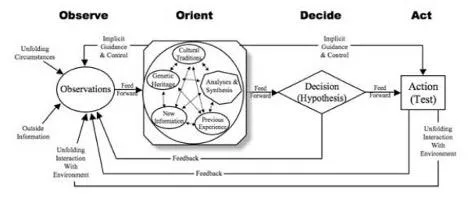2-SECOND BURSTS
SHORT THOUGHTS ON LEADERSHIP, DECISION-MAKING, FLIGHT, AND OTHER TOPICS OF THE DAY
ARTICLES

OODA: Using John Boyd’s Vision for Excellence
Colonel John Boyd was known by some as Genghis John for his in-your-face tactics and approach to arguments. He was known to be somewhat sloppy, a bully of ideas, and unorthodox in his approach to problem solving. But under his approach was a dogged genius that has become foundational to many military and business leaders. Part of his genius was encapsulated in the OODA Loop. Observe, Orient, Decide and Act.
Initially used for air-to-air combat, the “OODA” Loop has since been applied to problem solving, market analysis, military campaigns, and simple business decisions. It is genius in its simplicity, and transformational in how it frames literally any situation.
Taken a step further, the OODA loop is a baseline for effort, focus, and development individually, for a team, or a large organization. When used correctly, OODA can accelerate the decision-making of a team, reduce training and data-collection costs, and allow for more effective decision-making, and actions pointed towards success.
When we use the OODA loop, the first step is to know our objective, to understand what victory means to us in the given situation and overall. Without an understanding of what the desired end-state is, we are simply spinning our wheels and reacting in a survival mode that at best delays the inevitable failure.
Breaking it down by each component, Observation is the step where we take in our environment, the actions of others, the developing circumstances, and even the results of past decisions and actions. While we can drive certain observations through our previous actions, we don’t really get a vote on this phase of the Loop. The enemy, the other company, the weather, or even a sick child is all part of the Observation Phase. What we can control is the environment we find ourselves in. Knowing our desired end state, our observations should be pointed towards things that matter, things that will affect that end state. Too many miss effective Observation because of distractions and things that have nothing to do with the task at hand.
Based on our Observations, we move into the next phase of Orientation. We additionally orient based on those same objectives, our bias, experience, past observations, and with a lean towards pre-conceived decisions. With what we have seen, we analyze the environment through our own lens of what has worked in the past, cultural traditions, our previous baseline of information, our prejudices, and personal understandings.
Our Orientation then should move us towards a the Decide phase of the OODA Loop. Again, our Objectives should be at the forefront of our mind with every decision. This is coupled with our overall priorities, our perceived and actual direction based on those priorities and objectives, and a look forward to how the environment (the enemy) is going to react to our decision and action. Upon considering the key points of information, we Decide which action will move the needle in our favor.
The last phase of the OODA Loop is to Act. A great plan with no or poor execution is just as worthless as a poor plan. General George Patton once said, “A good plan, violently executed now, is better than a perfect plan next week.” With an objective-focused adherence to the OODA Loop process, the likelihood of a good plan is high.
With the action, the Loop starts all over again. In fact, the OODA Loop should be an ongoing series of observations, orientations, decisions and actions to move hopefully in the right direction and to constantly react effectively with the end in mind. In air combat—Boyd’s first application of the OODA Loop—a pilot will make literally hundreds of decisions a minute based on the weather, his equipment, the reactions and actions of his opponent, the effectiveness of his weapons, and how well he flies his own jet in the process.
Understanding the OODA Loop and applying it to any given environment can be the key to success for any individual and organization. It can be the key for effective application of resources, for understanding an opponent, and for learning wise decision-making paired with disciplined execution.
For example, a new company entering the market place has so many blind spots that the bulk of their efforts may initially revolve around the “Observation” phase. They don’t know what they don’t know, so they will have to spend excessive amounts of time studying the market, their opponents, the resources at hand, etc. Similarly, they will have to be careful in the “Orient” phase because of the ignorant prejudices they bring to the market, and their lack of understanding of the cues that fill the market. They often don’t know what they don’t know, so much approach the “Orient” phase with a great deal of humility. When it comes to the “Decide” phase, they cannot be timid, but must focus on ‘must do’ decisions that bring them towards their goals. They must understand that they have not yet learned the consequences of their decisions, so be ready to “Observe” and “Re-Orient” because of the unintended consequences. Lastly, when it comes time to “Act”, do so violently, in a disciplined way, completely owning the decision and manifesting that ownership through the action.
By the end of my flying career, flying one on one air combat against another squadron mate was very different than it was when I first started. I flew less than when I was younger, so my physical skills and reaction time was probably not as good. But I had “Observed” the varied situations so many times that my “Observation” phase was relatively quick. I ‘knew’ where to expect my opponent to be after a certain action on my part, or expected a certain reaction. Seldom was my “Orientation” of the situation wrong because I had come to know the physics of the aircraft in many different settings. This allowed me to blow through the “Decide” phase with confidence and quickly “Act” in a way that I knew would work. On the basketball court with my dad, we called his uncanny ability to hit unmake able shots and beat us routinely as “old man strength”. The same applied to me in the latter years as a pilot.
The same logic and rhythm applies to literally any endeavor. Knowing where your strengths are, ‘seeing’ something enough to help you “Observe” in an informed way, and quickly “Orient” you and your organization towards sound and rapid “Decisions” and “Actions" will ensure that your goals are more than just paper drills to satisfy yourself or shareholders.

CONTACT DEREK!

MEDIA INQUIRIES
Members of the press are welcome to contact us regarding any requests at [email protected] ;
(385) 777-6285

